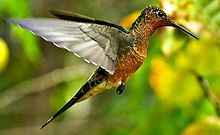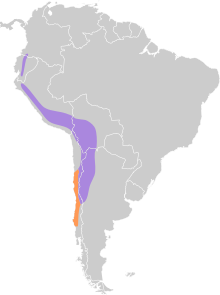Giant hummingbird
| Giant hummingbird | |
|---|---|

| |
| Patagona gigas in Chile | |
| Scientific classification | |
| Domain: | Eukaryota |
| Kingdom: | Animalia |
| Phylum: | Chordata |
| Class: | Aves |
| Clade: | Strisores |
| Order: | Apodiformes |
| Family: | Trochilidae |
| Genus: | Patagona G.R. Gray, 1840 |
| Species: | P. gigas
|
| Binomial name | |
| Patagona gigas (Vieillot, 1824)
| |

| |
The giant hummingbird (Patagona gigas) is the
Taxonomy
The giant hummingbird was
Two subspecies are recognised:[10]
- P. g. peruviana Boucard, 1893 – southwest Colombia to north Chile and northwest Argentina
- P. g. gigas (Vieillot, 1824) – central, south Chile and west-central Argentina
These subspecies are thought to have emerged as a result of partial geographical separation of populations by volcanic activity in the Andes predating the Miocene; however, there remain areas of contact between the species, hence the lack of full speciation.[12] The proposed phylogenetic system for hummingbirds suggested by McGuire et al. (2009)[13] accommodates the possible elevation of these subspecies to species rank.
Description

The giant hummingbird can be identified by its large size and characteristics such as the presence of an eye-ring, straight bill longer than the head, dull colouration, very long wings (approaching the tail tip when stowed), long and moderately forked tail,[14] tarsi feathered to the toes and large, sturdy feet. There is no difference between the sexes.[12][15] Juveniles have small corrugations on the lateral beak culmen.[16]
The subspecies are visually distinguishable. P. g. peruviana is yellowish brown overall and has white on the chin and throat, where P. g. gigas is more olive green to brown and lacks white on the chin and throat.[12]
The giant hummingbird occasionally glides in flight, a behavior very rare among hummingbirds. Its elongated wings allow more efficient glides than do those of other hummingbirds.[17] The giant hummingbird's voice is a distinctive loud, sharp and whistling "chip".[18]
Distribution and habitat
The giant hummingbird is widely distributed throughout the length of the Andes on both the east and west sides.[12] It typically inhabits the higher altitude scrubland and forests that line the slopes of the Andes during the summer and then retreats to similar, lower altitude habitats in winter months.[15][19] The species persists through a large altitude range, with specimens retrieved from sea level up to 4600 m.[12] They have shown to be fairly resilient to urbanisation and agricultural activities; however, the removal of vegetation limits their distribution in dense city areas and industrial zones.[20] The giant hummingbird migrates in summer to the temperate areas of South America, reaching as low as 44° S. Correspondingly, it migrates north to more tropical climates in winter (March–August), though not usually venturing higher than 28° S.[12][18]
P. g. peruviana occurs from Ecuador to the southeastern mountains of Peru and P. g. gigas from northern Bolivia and Chile to Argentina. Contact between subspecies is most likely to occur around the eastern slopes of the north Peruvian Andes.[12]
Behaviour
Hummingbirds are extremely agile and acrobatic flyers, regularly partaking in sustained hovering flight, often used not only to feed on the wing but to protect their territory[21] and court mates.[5] The giant hummingbird is typical in that it will brazenly defend its precious energy-rich flower territory from other species and other giant hummingbirds. These birds are typically seen alone, in pairs or small family groups.[18]
Flight, anatomy and physiology
The giant hummingbird hovers at an average of 15 wing beats per second, a slow rate for a hummingbird.[3] Its resting heart rate is 300 beats per minute, with a peak rate in flight of 1020 beats per minute.[3] Energy requirements for hummingbirds do not scale evenly with size increases, meaning a larger bird such as giant hummingbird requires more energy per gram to hover than a smaller bird.[22]
The giant hummingbird requires an estimated 4.3
Food and feeding

The giant hummingbird feeds mainly on nectar, visiting a range of flowers.
It regularly feeds from the flowers of the genus


Considering the energy-rich nature of nectar as a food source, it attracts a large range of visitors apart from the hummingbird, which has coevolved with a plant to be the flower's most efficient pollinator.[21][25][26] These other visitors, because they are not designed to access the well-hidden bounty of nectar, often damage the flowers (for example, piercing them at the base) and prevent further nectar production.[25] Because of its high energy requirements, the giant hummingbird alters its foraging behaviour as a direct response to nectar robbing from other birds and animals, and this reduces the viability of the hummingbird in an area with many nectar robbers, as well as indirectly affecting the plants by reducing pollination.[25] If alien species are introduced that become nectar thieves, it is reasonable to predict that their activities will significantly impact the local ecosystem. This could prove to be a future risk for the giant hummingbird populations because they sit close to the physical limit in their metabolic demands.[23]
Breeding
There is little known of the giant hummingbird's breeding behaviour, but some generalisations can be inferred from other hummingbird species. Hummingbird males tend to have polygynous, occasionally promiscuous, behaviours[5] and no involvement after copulation.[28] The female builds the nest and lays a clutch of two eggs during the summer.[29] A giant hummingbird nest is small considering the size of the bird, typically made near water sources and perched on a branch of a tree or shrub parallel to the ground.[18]
Cultural significance
The giant hummingbird holds significant value for some of the aboriginal inhabitants of the Andes. The people of
Status
The range of the giant hummingbird is sizable, estimated at 1,200,000 km2, with total numbers of about 10,000 adults. The species is classified by the
References
- ^ . Retrieved 12 November 2021.
- ^ "Appendices | CITES". cites.org. Retrieved 2022-01-14.
- ^ PMID 6079418.
- S2CID 31616893.
- ^ PMID 16753546.
- ^ Vieillot, Louis Pierre (1824). La Galerie des Oiseaux (in French). Vol. 1. Paris: Constant Chantepie. p. 296–297; Plate 180.
- ^ Hellmayr, Carl Eduard (1932). The Birds of Chile. Field Museum Natural History Publications. Zoological Series. Volume 19. Vol. 19. p. 230.
- ^ Peters, James Lee, ed. (1945). Check-List of Birds of the World. Vol. 5. Cambridge, Massachusetts: Harvard University Press. p. 95.
- ^ Gray, George Robert (1840). A List of the Genera of Birds : with an Indication of the Typical Species of Each Genus. London: R. and J.E. Taylor. p. 14.
- ^ Rasmussen, Pamela, eds. (August 2022). "Hummingbirds". IOC World Bird List Version 12.2. International Ornithologists' Union. Retrieved 13 September 2022.
- PMID 24704078.
- ^ a b c d e f g Osés, C. S. (2003). Taxonomy, phylogeny, and biogeography of the Andean hummingbird genera Coeligena Lesson, 1832; Pterophanes Gould, 1849; Ensifera Lesson 1843; and Patagona Gray, 1840 (Aves: Trochiliformes) (1st ed.). Bonn, Germany: Bonn University. Retrieved 18 April 2015.
- .
- .
- ^ doi:10.1676/07-111.1.
- JSTOR 4084114.
- .
- ^ a b c d e f g h Ricardo, R. (2010). Multi-ethnic Bird Guide of the Subantarctic Forests of South America (2nd ed.). University of North Texas Press. pp. 171–173.
- S2CID 85640049.
- .
- ^ S2CID 86659001.
- ^ S2CID 84151001.
- ^ PMID 21672723.
- ^ S2CID 86241862.
- ^ S2CID 84689385.
- ^ .
- S2CID 1095801.
- S2CID 25220383.
- S2CID 6748956.

